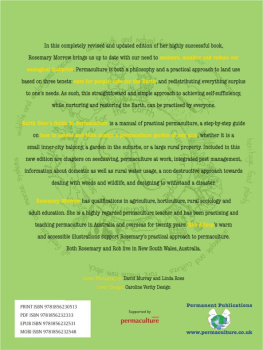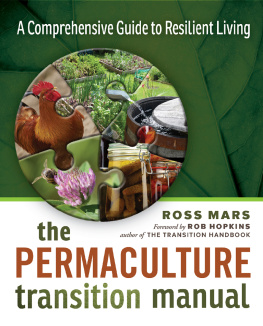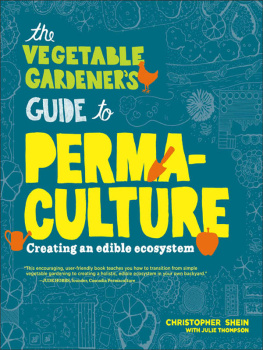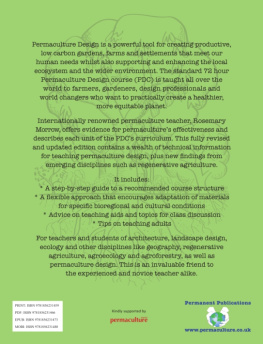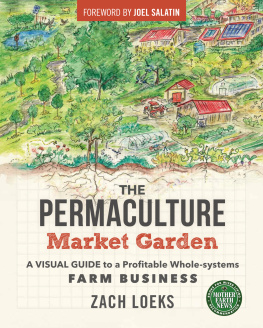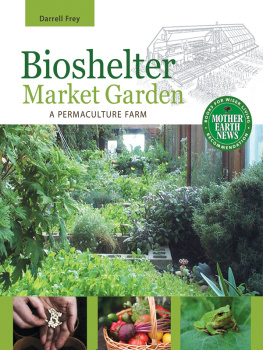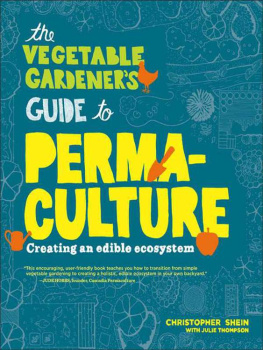May the Earth always speak to your spirit.
Published by
Permanent Publications
Hyden House Ltd, The Sustainability Centre, East Meon, Hampshire GU32 1HR, United Kingdom
Tel: 0844 846 4824 (local rate UK only) or 01730 823 311
Fax: 01730 823 322 Overseas: (international code +44 - 1730)
Email:
Web: www.permaculture.co.uk
Distributed in the USA by
Chelsea Green Publishing Company
PO Box 428, White River Junction, VT 05001
Tel: 802 295 6300 Fax: 802 295 6444
Web: www.chelseagreen.com
Second edition 2006 Rosemary Morrow
Reprinted 2009, 2012, 2013, 2015
The right of Rosemary Morrow to be identified as the author of this work has been asserted by her in accordance with the Copyrights, Designs and Patents Act 1998
Original edition published in Australia, under the title:
Earth Users Guide To Permaculture
Copyright Kangaroo Press, Simon & Schuster (Australia) Pty Limited,
Suite 2, Lower Ground Floor, 14-16 Suakin Street, Pymble, NSW 2073, Australia
www.simonsaysaustralia.com
Design by Avril Makula
Cover design by Caroline Verity Design
eBook conversion eBookPartnership, ebookpartnership.com
British Library Cataloguing-in-Publication Data
A catalogue record for this book is available from the British Library
PRINT ISBN 9781856230513
PDF ISBN 9781856232333
EPUB ISBN 9781856232531
MOBI ISBN 9781856232548
All rights reserved. No part of this publication may be reproduced, stored in a retrieval system, rebound or transmitted in any form or by any means, electronic, mechanical, photocopying, recording or otherwise, without the prior permission of Hyden House Limited.
Foreword
Permaculture has its origins and strongest foundations in Australia, but it is also a global movement with projects and groups in hundreds of countries. Its inclusion in The Macquarie Dictionary is an indication of its status as almost a household word. In Australia permaculture has provided an ethical and environmental design framework for personal and household self-reliance, rural resettlement and community development. But the total scope and scale of permaculture in Australia is dwarfed by its growth in Europe, North America and Japan. In affluent countries permaculture has provided the environmentally aware with ways to reduce their ecological footprint through a greater degree of self-reliance. It has also spread to many less affluent countries of Asia, Latin America, Africa and Oceania through development projects. In this context, permaculture has been potent in the provision of basic needs using local resources.
Rosemary Morrows decades of teaching and activism span the local and the global aspects of permaculture in rich and poor countries. The Earth Users Guide to Permaculture is very much a manual of practical permaculture. It is an especially useful book for home and land owners in Australian temperate regions but is also applicable more widely. This revised and updated edition shows a strong ethical sense of the global context as well as practical experience and examples of how the same concepts apply in very different climates and cultures.
Permaculture is sometimes understood as the work of one man, Bill Mollison. In fact, a diversity of people have contributed to its foundations, growth and spread, including Rosemary Morrow. With this new edition of Earth Users Guide to Permaculture, Rosemary Morrow consolidates her substantial and ongoing contribution to the understanding and application of permaculture as a design system for living lightly and yet abundantly on this earth.
DAVID HOLMGREN
Co-originator of the permaculture concept

The three attitudinal principles of permaculture: care for people, care for the Earth, and redistribute surplus to ones needs.
Contents
Acknowledgments
You cant do anything on your own. (Vietnamese saying)
Thank you, Rob Allsop, for your careful and painstaking work and wonderful friendship. Thanks also to Liz Connor, Sue Girard, Jill Finnane, Lyndall Sullivan, Veechi Curtis, Leanne Huxley and her family for the water policing statistics (Leannes word), Brian Coates, and Lyn Godfree for stretching my ideas and adding their experiences. My friend Margot Turner had the inspiration and added to the chapter on permaculture at work. She also supplied the materials for the chapter. Her support has added considerably to the scope and relevance of permaculture at work.
The motivation for this book comes from the hundreds of students who have completed short and long courses with me, and whose evaluation always asked for more tangibles please. I truly hope that this book will go some way towards meeting their needs.
There have been people in the Blue Mountains where I live who have carried me through computer despair when I seized up; in particular, Ted Markstein and Kai Green.
Thanks to Julia Collingwood at Simon & Schuster and Katrina Herborn, my doctor, who convinced me to work on this new edition after I had a stroke. And to Glenda Downing, my editor, who has become a friend through lots of sympathetic discussions.
Thanks are due also to permaculture teachers with whom I spent some hours in discussion.
And how can I say thank you to people in other countries, where I brought the ethics and principles and they added the rest Gia, Nguyen Van Gia, Le Phuong, Em Ponna, Kosal Neary, Koli Stafa, Edi Mullah and many, many others who started permaculture, never having seen it in the field. You are wonderful.
Introduction
The world has changed. Most of Earths citizens are now aware of the degradation of water, soils, forests and air quality, and that this destruction is accelerating. We know we are living in an age of energy and freshwater peak and decline and the future does not look pleasant unless we move creatively into the future, changing our attitudes and lifestyles. However, it is not simply enough to slow down the destruction; we must work to reverse it. Permaculture provides us with the skills and knowledge to do this in ways that are creative and satisfying. Much of permaculture is repair.
We appear to have reached a tipping point or critical mass where it will now only take a small change for systems to break down. We can think of it as putting more and more weight on a stick until it suddenly breaks. But all of us can easily reduce our impact on Earths scarce resources by acquiring knowledge and skills. We can guard our future by living lightly and consuming thoughtfully.
Not only have our ecosystems become more vulnerable but our lives are now also directly threatened. In this edition attention is given to individual and community resilience and self-reliance through design and community structures. Permaculture may be the only integrated wholistic model we have to build a more secure future or, at least, help us cope with an uncertain one.
Some good has come from awareness of our human impact. Many of us know the value of insulation, water harvesting and native vegetation. Compost and mulch are no longer mysteries. Permaculture is a recognised word. More people are rejecting plastics and many more are reducing waste. Some people use ethical investment, others are aware of their ecological footprint. While this is not enough to change the trend towards a diminished and difficult future, it provides hope that we can create pockets of stability and regeneration. Governments are not to be depended on for the leadership we require. Permaculture is at the vanguard of change through individual action, advocacy and co-operative groups.

